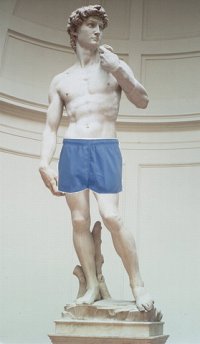
|
SCNA NUDIST FORUM
Return to Nudist Forum Menu |

|
A SALT LAKE PROFESSOR ASKS
“WHY DO PEOPLE WANT TO
From an article by Becky Wright, Salt Lake Tribune
10/1/2006, Salt Lake City, Utah – Art history professor says for nearly as long as there have been nudes in art, people have been trying to cover them up.
So, why is there so much nudity in art, and why have there always been people who wanted to cover it up?
That's the question professor Alexandra Karl asked almost a decade ago. Her research became a lecture, “From the Fig Leaf to the Bed Sheet. Or, Why Is There So Much Nudity in the Visual Arts?” that she presented last weekend at the Utah Museum of Fine Arts.
Karl, an adjunct professor of art history at the University of Utah, said she began giving serious thought to the use of nudity in art in 1997, when she heard that Auguste Rodin's sculpture, "The Kiss," had been removed from an exhibit at Brigham Young University's Museum of Art.
Karl admits she was originally "determined to ridicule the good BYU curators." While exploring the reasons artists have used nude images, she realized that she couldn't single out BYU.
In August, a patron asked the Davis County Library to move Utah artist James C. Christensen's 1996 book "The Voyage of the Basset" to the adult section because it contains images of unclothed mermaids. Christensen says he was surprised because the book has been in libraries across the country for years, and he had never heard anything negative about it before.
Utah is known as conservative, but censorship isn't limited to a conservative state in modern times.
"The controversy goes all the way back to Michelangelo. He painted the figures in 'The Last Judgment,' and another artist was asked to come in and paint little draperies over their loins," said Matthew Choberka, assistant professor of art at Weber State University.
Over the centuries, Karl says, nude figures have been covered with everything from fig leaves to aprons and black strips. People have even broken off pieces of statues that were deemed offensive.
"There's a room in the British Museum of Art called the 'Secretum,' which is Latin for the 'Secret Museum,' and it has all these phallus that have been hacked off," she said. "It's a peculiar phenomenon to think that there is this one room that contains all of the naughty bits of statue, and a full museum has all of the bodies without their bits."
Karl says the censorship is counterproductive.
"Mark Twain went to Uffizi Gallery in Florence, and there's a statue outside of the Uffizi Gallery of a pagan idol with a fig leaf on his genitals. And Mark Twain said, 'Before, probably nobody even noticed his nudity, but the fig leaf makes it so obvious ...' "
Karl says nude figures in Western art date back at least to ancient Greece.
"Some of the reasons the Greeks made their works nude ... can be traced to the writings of Socrates, who emphasized a sort of new observation of the human body," she said. "In order to study the human body, artists would go to gymnasiums. ... The
wrestlers would be working out in the nude, and consequently, sculptors studied them in the nude."
University of Utah art professor Sam Wilson says the nude regained popularity during the Renaissance as the study of classic literature and art gave rise to humanism, with the human being at the core. "Drawing the human figure was seen as the most noble thing an artist can do," he said.
Karl says it's not just about choosing to create a nude, but choosing to avoid clothing.
"It's really hard to clothe a statue and not immediately limit its applicability. If you put a waistcoat and cane on a man, it situates him in a certain time as much as if they're wearing a toga," she said. "Clothes are quite problematic in that they limit the historical accessibility of the work, and if you do away with the clothes, the body becomes kind of timeless."
Choberka suggests that people get riled up about nudes because they don't understand the distinction artists make between nakedness and nudity.
"Kenneth Clark, an English artist, wrote a book called 'The Nude' in 1956, that makes a distinction between the naked and the nude. The 'naked' being an uncomfortable and embarrassing reality that none of us would want to stand. ... The nude in art is actually clothed, in a sense, with balance, order and purity," said Choberka.
While Choberka sees the figure as essential to art, he knows there is a percentage of the population that believes nudity is never appropriate.
K. Stevenson, an associate professor of art at WSU, takes the idea a step further. "For others, that may be the problem, because it calls ideas into question."
"I don't think it's so much right or wrong as whether it's appropriate to the purpose -- and I don't necessarily mean its appropriateness to have the figure, if it was a nude, in a place or not -- but in terms of what the discussion is with that
|